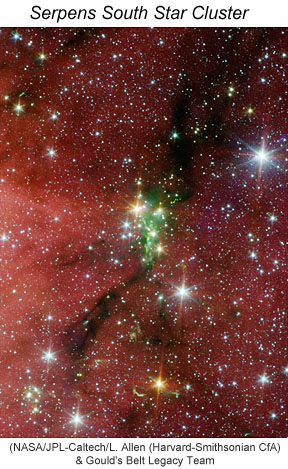Citation: Taylor, G. J. (November, 2012) Dating Transient Heating Events in the Solar Protoplanetary Disk. Planetary Science Research Discoveries. http://www.psrd.hawaii.edu/Nov12/ages-CAIs-chondrules.html (date accessed).
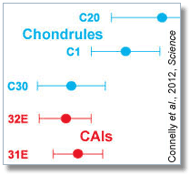 |
November 16, 2012
Dating Transient Heating Events in the Solar Protoplanetary Disk
--- Startlingly precise dating of components in primitive meteorites indicate contemporaneous formation of calcium-aluminum-rich inclusions (CAIs) and chondrules.
Written by G. Jeffrey Taylor
Hawai'i Institute of Geophysics and Planetology
Chondrites contain millimeter- to centimeter-sized objects that formed as the Solar System was still forming, allowing cosmochemists to do hands-on astronomy. Using advanced, mass spectrometry techniques, James Connelly (University of Copenhagen, Denmark) and colleagues there and at the University of Hawai'i and the Vernadsky Insitute for Geochemistry and Analytical Chemistry, Moscow, measured the abundances of lead and uranium isotopes in calcium-aluminum-rich inclusions (CAIs) in the CV carbonaceous chondrite Efremovka and chondrules in Allende (CV) and in the unequilibrated ordinary chondrite Northwest Africa 5697 to determine their absolute ages. The results show that CAIs formed 4567.30 ± 0.16 million years ago, suggesting that CAI formation occurred within a narrow time interval of about 160,000 years. Analyses of chondrules indicate that chondrule formation began during this time and continued for 2-3 million years. These time scales are consistent with astronomical observations of infant stars, leading Connelly and colleagues to suggest that CAIs and chondrules record processes common to the accretion disks surrounding young stars. This implies that cosmochemists studying these primitive, ancient objects in chondrites are studying typical products of star formation.
Reference:
- Connelly, J. N., Bizzarro, M., Krot, A. N., Nordlund, Å., Wielandt, D., and Ivanova, M. A. (2012) The Absolute Chronology and Thermal Processing of Solids in the Solar Protoplanetary Disk, Science, v. 338, p. 651-655, doi: 10.1126/science.1226919.
- PSRDpresents: Dating Transient Heating Events in the Solar Protoplanetary Disk--Short Slide Summary (with accompanying notes).
The Earliest Solids
Chondrites contain the oldest materials to form in the Solar System, calcium-aluminum-rich inclusions (CAIs) and chondrules. These primitive bits of the protoplanetary disk contain a meticulous record of processes that operated as the Sun and the surrounding disk were forming from an interstellar cloud. Cosmochemists use chondrules and CAIs to see far back in time to understand heating events in the disk and the timing of those events, the disk composition and evolution, transport of materials throughout the disk, the process of condensation of hot gas, and the role of transient heating events associated with formation of the Sun. It is hands-on astronomy.
 |
| A cut surface of the Allende meteorite (CV carbonaceous chondrite) with arrows pointing to CAIs and chondrules. These objects are pristine remnants of processes operating in the disk surrounding the Sun as it formed. James Connelly and his colleagues used the latest procedures to determine the ages of CAIs and chondrules. |

|
| Calculated sequence of minerals that condense as solids from a gas of solar composition at various pressures (the right side of the diagram is for the highest pressure, equal to that at the surface of Earth). Note that corundum (aluminum oxide) and assorted minerals rich in calcium (Ca), aluminum (Al), and titanium (Ti) are the first to form. These make up the main ingredients of the most refractory CAIs. Chondrules form from lower temperature condensates (region labeled Ca-pyroxene + metal + olivine + feldspar + orthopyroxene) or at higher pressure (right side of diagram), which might have been attained in dust-rich regions of the protoplanetary disk (see PSRD article Tiny Molten Droplets,Dusty Clouds, and Planet Formation. Believe it or not, this complicated diagram is a simplified version! Click for more information. |
Unraveling the events and processes operating as the Sun formed and the surrounding protoplanetary disk evolved requires determining precise ages of CAIs and chondrules. Cosmochemists had thought they had determined the relative ages of these primitive objects by using the inferred abundance of the short-lived isotope 26Al that decays to 26Mg with a half-life of 0.73 million years. The data suggested that CAIs formed first, followed by a period of chondrule formation 1-2 million after CAI manufacture had finished. The time gap suggested that the processes responsible for formation of these two distinctive types of primitive materials were different, with CAIs thought to form by condensation of hot gas (see PSRD article The First Rock in the Solar System. However, the 26Al-26Mg method rests on the assumption that the 26Al was distributed uniformly throughout the protoplanetary disk, or at least was uniformly distributed in the regions in which CAIs and chondrules formed. This may not be the case: Sasha Krot (University of Hawai'i) and colleagues have shown that about half the corundum grains (the first to form in the Solar System, as shown in the diagram above) contain very little 26Al. This uncertainty led Connelly and colleagues to use an age system based on long-lived isotopes, which use present-day values of isotopes in a sample, clearing the decks of at least one assumption. They chose the lead-lead (Pb-Pb) method.
Improving Instruments, More Precise Ages
The Pb-Pb method uses the decay of two radioactive isotopes of uranium (U) to Pb: 235U that decays to 207Pb, and 238U that decays to 206Pb. The equation below shows how an age is calculated. In the equation, 207Pb*/206Pb* is the ratio of the lead isotopes produced by radioactive decay in a CAI or a chondrule, 235U/238U is the present-day ratio of the two uranium isotopes, λ is the decay constant for either 235U or 238U (λ is related to half-life), and t is time. (Note that the uranium isotopic ratio is usually expressed as 238U/235U and has a value of 137.88.)

Actually determining an age requires determining the lead isotopic ratio in a mass spectrometer. It turns out that measuring the ratio of one isotope to another is quite accurate in a mass spectrometer. One trick is that we need to determine 207Pb*/206Pb*, which is produced by radioactive decay, but samples contain some of each isotope to begin with. This can be unraveled by measuring samples with different relative amounts of uranium and lead in them, and extrapolating back to no initial lead. Sounds impossible, but can be done as explained below.
A particularly thorny complication was pointed out by Gregory Brennecka (Arizona State University) and colleagues. They noted that it is not correct when working with these ancient samples to assume that the uranium isotopic ratio is constant. (See PSRD article by Greg Brennecka: A Complication in Determining the Precise Age of the Solar System.) The potential for 235U/238U varying in CAIs and chondrules required James Connelly and his colleagues to measure the uranium isotopes, an additional difficult measurement to make besides measuring lead isotopic compositions on these small samples. Fortunately, the isotope facilities at the Centre for Star and Planet Formation at the University of Copenhagen are world class and the practitioners are excellent. The labs include ultra-clean rooms for chemical separations and state-of-the-art mass spectrometers. The research team set out to extract CAIs and chondrules from carbonaceous chondrites and to make the difficult isotopic measurements, all in order to determine the ages of events that took place at the dawn of the Solar System, when even the Sun was still gestating.
Absolute Ages and Star Formation
The traditional way of extracting objects from meteorites (or any rock) is to cut the rock into slabs and chip or drill out the samples. Connelly and team followed this procedure to extract chondrules from the Allende carbonaceous chondrite and Northwest Africa 5697 unequilibrated ordinary chondrite. But this can be a bit hit or miss. Brain surgeons do not do this to find a tumor in someone's noggin. Instead, they use X-ray Computed Tomography (CT scans) to obtain a three-dimensional picture of your head. CT works for rocks, too, and it is becoming more widely used in meteorite studies. See, for example, Denton Ebel's (American Museum of Natural History) site Tomography of Chondrules.
Samples of the Efremovka carbonaceous chondrite were scanned at Moscow State University (Russia) by co-author Marina Ivanova. CAIs identified in the CT images were then surgically removed using a wire saw, a variable speed drill using cutting tools and dental drill bits. After all that careful work, chips were taken for optical microscope and electron microbeam studies and the rest crushed for isotopic analysis.
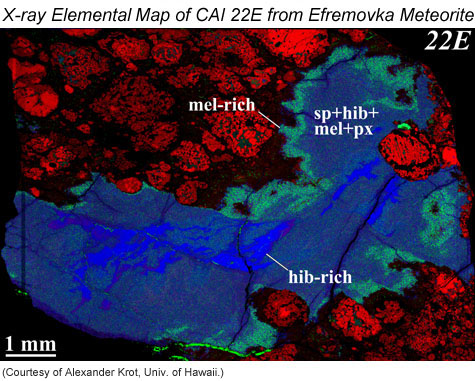
|
| Elemental map of a CAI (designated 22E) in the Efremovka CV3 carbonaceous chondrite. Note the presence of refractory minerals such as spinel (MgAl2O4), hibonite (CaAl12O19), and melilite (Ca2Al2SiO7 - Ca2MgSi2O7 solid solution). The inclusion is a fine-grained CAI having a group II rare earth element pattern, indicative of a condensation product. Surrounding materials are rich in magnesium. The image is a colorized according to the concentrations of magnesium (red), calcium (green), and aluminum (blue), as determined by element mapping by electron microprobe. Abbreviations: mel is melilite, a mineral rich in aluminum; sp is spinel; hib is hibonite; px is pyroxene. |
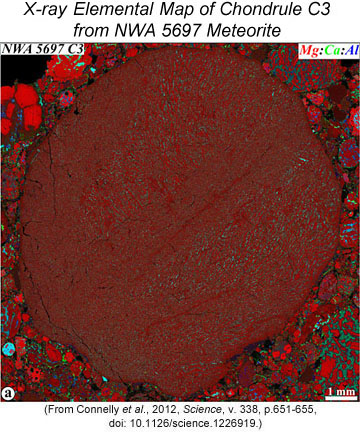
|
| This round object is one of the chondrules studied by James Connelly and his colleagues. It is surrounded by other chondrules and chondrules fragments in the unequilibrated ordinary chondrite NWA 5697 (found in the desert of northwest Africa). The image is a colorized according to the concentrations of magnesium (red), calcium (green), and aluminum (blue), as determined by element mapping by electron microprobe. |
The samples, painstakingly removed and then crushed to powders, were then subjected to sequential treatments in mixtures of acids, with solid residues and the accompanying acid solutions removed periodically to produce samples with a range of lead concentrations. Connelly and coworkers then used a mass spectrometer to measure the isotopic compositions in the acid-treated powders and solutions, producing diagrams with straight lines called isochrons (see below for an example). The y-intercept gives the 207Pb*/206Pb* value, from which an age can be calculated. Uranium isotoic compositions were used to calculate the ages correctly, but the results show that all chondrules measured had the same uranium isotopic composition found for differentiated meteorites, bulk chondrites, and terrestrial, lunar, and martian samples. The CAIs vary in the uranium isotopic ratio, which Connelly and coworkers ascribe to processes that produced the CAIs. The good news is that anyone wishing to determine the Pb-Pb age of any planetary material except CAIs can assume the standard ratio--no need to do those tricky uranium isotope measurements.
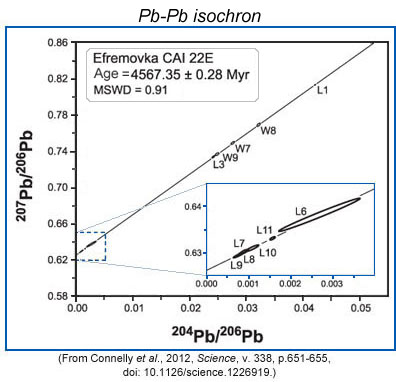 |
| Pb-Pb isochron diagram for the CAI in Efremovka pictured above. The samples are assorted solid (data with "W") and liquid ("L") products of acid treatments of the sample. 204Pb is not produced by radioactive decay and is an indication of the total lead content of a sample. When extrapolated to zero, the y-intercept gives the 207Pb*/206Pb* of the sample, allowing the age to be determined according to the equation shown above. |
The age data on the analyzed CAIs (from Efremovka) and chondrules (from Allende and NWA 5697) indicate that the CAIs formed at almost the same time (see diagram below). The average age of the CAIs is 4567.30 ± 0.16 million years, which suggests a time interval of only 160,000 years (0.16 million years) for formation of CAIs in CV chondrites. Equally important, one of the chondrule ages falls in the narrow range of ages of the CAIs, 4567.32 ± 0.42 million years. Other chondrules are younger, down to 4564.71 ± 0.30 (2.6 million years younger than CAIs). This indicates that formation of CAIs and chondrules overlapped in time, suggesting that the same physical processes generated the energy needed for heating and melting of CAIs and chondrule precursor dust. Studies of numerous young, still-forming stars indicate that the typical lifetime around low-mass stars (like our Sun) is about 3 million years, similar to the total time of CAI and chondrule formation.
The striking similarity between measured CAI and chondrule ages and the time scales of events around other stars with masses similar to our Sun indicate that our Solar System is not unique. Disappointing as this may be to those who think of themselves as the center of the universe, it is actually good because detailed measurements like those by Connelly and coauthors of the ages of meteorite components can be applied to star-forming regions in general. Continued detailed studies by cosmochemists of primitive chondritic meteorites will reveal details of the star-forming processes. This area of research is a fascinating link between cosmochemistry and astronomy, showing the value of studying the heavens down to nanometer-scale in our labs to light years through our telescopes.
- PSRDpresents: Dating Transient Heating Events in the Solar Protoplanetary Disk--Short Slide Summary (with accompanying notes).
- Brennecka, G. A. (January, 2010) A Complication in Determining the Precise Age of the Solar System. Planetary Science Research Discoveries. http://www.psrd.hawaii.edu/Jan10/Curium-247.html.
- Brennecka, G. A., Weyer, S., Wadhwa, M., Janney, P.E., Zipfel, J., and Anbar, A.D. (2010) 238U/235U Variations in Meteorites: Extant 247Cm and Implications for Pb-Pb Dating. Science, v. 327(5964), p. 449-451.
- Connelly, James N., Bizzarro, Martin, Krot, Alexander N., Nordlund, Åke, Wielandt, Daniel, and Ivanova, Marina A. (2012) The Absolute Chronology and Thermal Processing of Solids in the Solar Protoplanetary Disk, Science, v. 338, p. 651-655, doi: 10.1126/science.1226919. [abstract]
- Simon, S. B. (October, 2002) The First Rock in the Solar System. Planetary Science Research Discoveries. http://www.psrd.hawaii.edu/Oct02/firstRock.html.
- Taylor, G. J. (November, 2008) Tiny Molten Droplets, Dusty Clouds, and Planet Formation. Planetary Science Research Discoveries. http://www.psrd.hawaii.edu/Nov08/chondrule_sodium.html.
|
|
[ About PSRD | Archive | CosmoSparks | Search | Subscribe ] [ Glossary | General Resources | Comments | Top of page ] |


